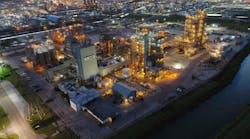Growth in the energy markets, especially in oil and gas, is creating greater demand for the accuracy and reliability of Coriolis flowmeters, according to a new market study from Flow Research. The market for Coriolis flowmeters totaled $1.3 billion in 2013, and is projected to grow to almost $2 billion by 2018.
High crude oil prices are a part of this equation. Flow Research says Coriolis flowmeters remain the most accurate flowmeter made, and both accuracy and reliability are critically important for measuring the flow of crude oil and petroleum liquids. While Coriolis flowmeters are used for both upstream and downstream petroleum applications, they are especially suited to downstream applications of petroleum liquids.
Large Line Size Meters Drive Usage
Another important force driving the market is the development of large line size Coriolis flowmeters. For many years, nearly all Coriolis flowmeters were used in pipes with diameters of 6” or less. In the past five years, four major suppliers have developed Coriolis flowmeters for use with pipes from 8” to 16” in diameter. While these flowmeters can be quite expensive, they are becoming increasingly popular with flowmeter users, Flow Research says. Most of these large line size Coriolis flowmeters are designed for custody transfer applications. Companies that have brought out these large line size meters include GE Measurement (which acquired Rheonik), Micro Motion (part of Emerson Process Management), Endress+Hauser, and KROHNE.
Industry Approvals Help Coriolis Adoption
Flow Research says Coriolis flowmeters have also benefited from industry approvals that previously worked mainly in favor of differential-pressure (DP) and turbine flowmeters. The American Gas Association approved a report on the use of natural gas for custody-transfer applications in 2003. This report helps explain the growing use of Coriolis flowmeters for natural gas. The American Petroleum Institute (API) has also issued a draft standard for the use of Coriolis flowmeters to measure hydrocarbon fluids. This document was added to the API Library in July 2012. The API also approved a draft standard called Measurement of Crude Oil by Coriolis Meters. While Coriolis flowmeters compete with differential-pressure and turbine flowmeters for natural gas applications, they compete with positive-displacement (PD) flowmeters for downstream measurement of petroleum liquids.
Chemical Industry Largest Market for Coriolis
While the use of Coriolis flowmeters is growing rapidly in the oil & gas and refining industries, the chemical industry remains the largest industry for Coriolis flowmeters. They are also widely used in the food & beverage and pharmaceutical industries. All these industries have sanitary applications where Coriolis flowmeters do well. Coriolis flowmeters compete with magnetic flowmeters for sanitary applications. Magnetic flowmeters have specialized liners that make them especially suited for sanitary applications. While most Coriolis flowmeters have single- or dual-bent tubes, fluids are less likely to build up in straight-tube meters since the fluids don’t have to travel around bends or curves. Straight-tube meters also have less pressure drop than bent-tube meters.
Liquid Measurement Remains Top Flow Application
Even though Coriolis flowmeters are being used more widely to measure both natural gas and industrial gases, liquids still account for more than 75 percent of Coriolis flow applications. Liquids are denser than gas, and Coriolis flowmeters rely on the momentum of the fluid as it travels through the meter to generate the flowmeter measurement. And even though measurement of the flow of petroleum liquids is growing at a faster rate than measurement of non-petroleum liquids, measurement of non-petroleum liquids still represents a larger segment of the fluid measurement market.
Continued Expansion Forecast
According to Jesse Yoder, Ph.D., president of Flow Research, continued expansion is expected for the Coriolis flowmeter market. “Continued growth in the energy markets is a major reason for projected growth in the Coriolis flowmeter market,” Yoder said. “At the same time, Coriolis suppliers have shown a readiness to bring out new products to meet new and changing market requirements. This is shown in the development of both straight-tube and large line size Coriolis flowmeters. Even though they remain somewhat expensive, the twin benefits of high accuracy and long-term reliability outweigh the upfront purchase price of Coriolis flowmeters for many flowmeter users.”
The Coriolis flowmeter market size and forecasts are part of a new research study from Flow Research, Volume X: The World Market for Flowmeters, 5th Edition. This study includes 12 flowmeter types, and covers both new-technology and traditional technology flowmeters. Coriolis flowmeters are included among the new-technology flowmeters. Flow Research has also published a standalone study on Coriolis flowmeters called The World Market for Coriolis Flowmeters, 4th Edition.


